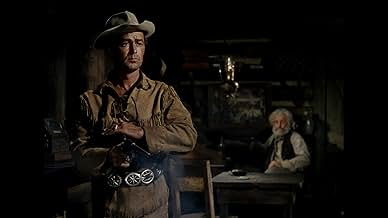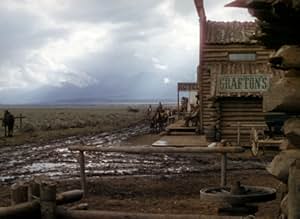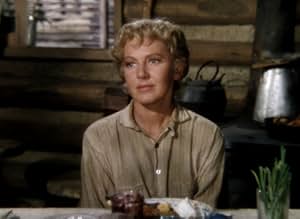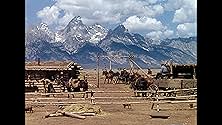Shane, un cavalier solitaire et mystérieux, arrive dans un village du Wyoming. Il devient l'ami de la famille Starret. Mais un propriétaire sème la terreur à l'aide d'un tueur redoutable. Qu... Tout lireShane, un cavalier solitaire et mystérieux, arrive dans un village du Wyoming. Il devient l'ami de la famille Starret. Mais un propriétaire sème la terreur à l'aide d'un tueur redoutable. Qui osera l'affronter?Shane, un cavalier solitaire et mystérieux, arrive dans un village du Wyoming. Il devient l'ami de la famille Starret. Mais un propriétaire sème la terreur à l'aide d'un tueur redoutable. Qui osera l'affronter?
- Director
- Writers
- Stars
- A remporté 1 oscar
- 8 victoires et 13 nominations au total
- Jack Wilson
- (as Walter Jack Palance)
Avis en vedette
The story is one of those ones which has plenty of mileage in it. Alan Ladd plays a retired gunslinger who joins up with a group of settlers, including Van Heflin who is fine in support and bags a more interesting character than Ladd's. The settlers find themselves up against Emile Meyer as the cruel Ryker, and his various men including veteran genre star Ben Johnson and Jack Palance in a truly evil, star-making performance. Elisha Cook Jr. is here too, playing a tougher character than you'd expect.
A lot of the material is told through the eyes of your typically annoying American kid, but thankfully he's not too grating and at least his heart is in the right place. There's plenty of suspense and drama to keep the tale moving, but it's the action which really hits home. The excellent climax is a given - and Eastwood would later reference it in UNFORGIVEN - but it's the bar-room brawl which is something else, one of the most powerful fist-fights I've seen on a film. Top stuff indeed.
There are so many scenes in SHANE that standout as epic. They are like the jagged mountainscapes that dominate the picture: A young boy, slogging around in a marsh, aims his toy gun on a deer grazing on some grass stems, the deer lifts it's antlers and perfectly frames a lone rider approaching in the distance, a struggling family homestead held together by hard work, the father splitting wood, the mother baking in the kitchen, and always the mountains jutting upwards away off in the distance.
We have a stranger, lean and handsome, dressed in fringed buckskin. His dress and gun belt suggest something other than a farmer or rancher, yet we never really know, or ever know, of his past. He is kind and modest, and takes time to address the boy as though someone worth talking to, "You were watching me down the trail quite a spell, weren't you. I like a man who watches things going around.....He can make his mark someday." the boy smiles up at him, and an instant bond is formed, an idol worship in the making.
We have snickering, troublesome ranchhands who spend any free hours swilling whiskey at Graftons General Merchantile. "I thought I smelled pig. Which one of those tatter-pickers are you working for? Or are you just squattin' on the range?" this is the kind of menace that dogsany farmer who dares to come into town.
We have Shane, although trying to lead the simple life of farming, goaded into a fight by a sweaty-faced cowpoke (Ben Johnson). His bloodying of the cowpoke is like a violent ballet, graceful and cutting.
There is a meeting of the homesteaders, huddled together by lamplight, trying to solve there problems by resolving to go into town all together so that they would have strength in numbers. This is a rather sad scene since WE know that will be in vain.
There is touching elegance to the 4th of July celebration where there is fiddle music and dancing. Shane and Marion (the boy's mother) take a few turns to a reel..... dancing with others in the corral. Van Heflin (the Boy's father) is symbolically shut out beyond the fence. "Marion, they fenced me out" he grins. Yet we know that there is a growing affection between the two dancers.
There is tension in the late evening when the head of the ranchers pays visit to the homestead. "Look Starrett. When I come to this country you weren't much older than your boy there........ How would you like to go partners with me." It's sad because this is a real if clumsy attempt to "be reasonable" But as Shane would say on more than one occasion, "it's no use".
I could go on; the murder of the Stonewall at the hands of an especially evil hired gun from Cheyenne has great impact. And, the final confrontation at Graftons one fateful night, is one of the best in Westerns.
The characters are well developed and the story, while exiting, is a little melancholy.
The best Western ever made.
Le saviez-vous
- AnecdotesPrincipal photography had been completed in October, 1951, but the amount of coverage shot by George Stevens resulted in such an extremely protracted editing process that the film wasn't released until August, 1953. All this drove up the costs of what should have been a simple, straightforward Western; in fact, they spiraled so much that Paramount approached Howard Hughes about taking on the property, but he declined. He changed his mind when he saw a rough cut and offered to buy the film on the spot. This made Paramount rethink its strategy--originally it was going to release it as a "B" picture but then decided it should be one of the studio's flagship films of the year. This proved to be a good decision, as the film was a major success and easily recouped its inflated budget.
- GaffesAt the beginning, when Shane rides a horse down the hill, Teton Pass Highway is visible in the background.
- Citations
Shane: I gotta be going on.
Joey: Why, Shane?
Shane: A man has to be what he is, Joey. Can't break the mould. I tried it and it didn't work for me.
Joey: We want you, Shane.
Shane: Joey, there's no living with... with a killing. There's no going back from one. Right or wrong, it's a brand. A brand sticks. There's no going back. Now you run on home to your mother, and tell her... tell her everything's all right. And there aren't any more guns in the valley.
Joey: Shane...
[Joey notices that Shane is wounded]
Joey: It's bloody! You're hurt!
Shane: [Shane starts to stroke Joey's hair] I'm all right, Joey. You go home to your mother and father and grow up to be strong and straight. And, Joey... take care of them, both of them.
Joey: Yes, Shane.
[Shane rides off]
- Générique farfeluIntroducing Brandon De Wilde
- Autres versionsThe film was shot in Academy Ratio (1.33:1 or 4:3), but this was done around the time widescreen filmmaking was coming around. As such, many theatres cropped the film into a widescreen ratio to take advantage of this, with many DVDs being cropped as well. The 2013 Blu-ray Disc release is in the proper Academy Ratio.
- ConnexionsEdited into Go West, Young Man! (2003)
- Bandes originalesAbide With Me
(uncredited)
Music by William H. Monk (1861)
Hymn by Henry F. Lyte (1847)
Played on piano and sung by many at a meeting
Also played and sung at a funeral
Meilleurs choix
Détails
Box-office
- Budget
- 3 100 000 $ US (estimation)
- Brut – à l'échelle mondiale
- 21 412 $ US
- Durée
- 1h 58m(118 min)
- Couleur
- Rapport de forme
- 1.37 : 1(original aspect ratio)




































